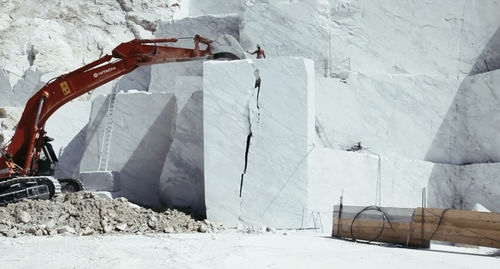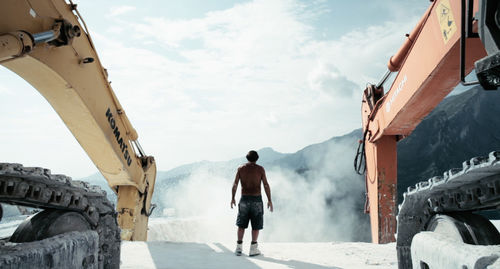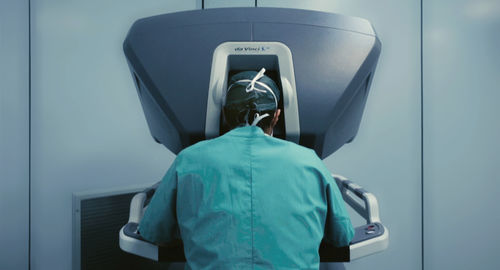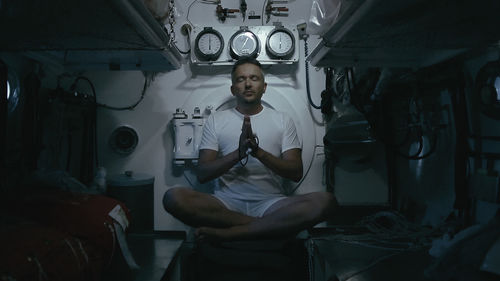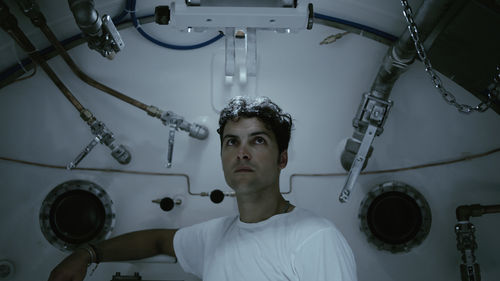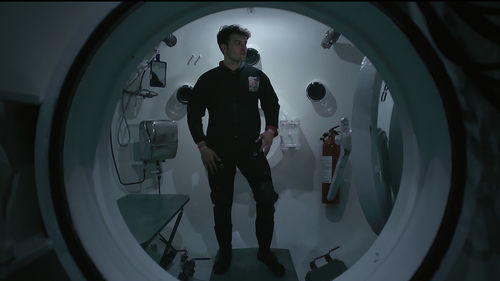
Hammer Projects: Yuri Ancarani
- – This is a past exhibition
Italian artist Yuri Ancarani makes seductive, hypnotic, engrossing films that delve deep into obscure subjects. This is his first solo exhibition in the U.S., and it will feature La malattia del ferro (The disease of iron; 2010–12), a trilogy of short films, each focusing on a highly specialized occupation. The title refers to a syndrome similar to cabin fever, which sailors experienced after being out at sea for great lengths of time. The first film in the series, Il Capo (2010) is a beautiful portrayal of the Carrara marble quarry and the magnanimous foreman directing his crew like an orchestra conductor. Piattaforma Luna (2011) takes us inside the rarely seen daily routine of scuba divers on board a submarine, stationed deep below the surface of the ocean. Da Vinci (2012), features a surgical robot whose mechanical arms perform an operation (guided by a surgeon working remotely), and exquisitely captures the procedure from the inside and out. Together, the three films explore the interdependent relationship between man and machine and the beautiful choreography of labor.
Hammer Projects: Yuri Ancarani is organized by Hammer curator Ali Subotnick with Emily Gonzalez, curatorial associate.
Biography
Essay
Hammer Projects: Yuri Ancarani
By Ali Subotnick
In the Italian filmmaker Yuri Ancarani’s trilogy of short films titled La malattia del ferro (The disease of iron; 2010–12), viewers are ushered into the hidden worlds of three very distinct and extremely specialized occupations: marble miners, scuba divers, and surgeons. The title refers to a syndrome something like cabin fever, in which workers who have spent a lot of time at sea have trouble adjusting to life on dry land. The laborers in each of these films appear to be completely removed from ordinary life. They are everyday heroes, alone together, just the workers and the machines that they rely on to do their work. Each of the films in the trilogy demonstrates the interdependent relationship between man and machine in a subtle yet compelling manner. Il Capo (2010) captures miners working with industrial digging machines or excavators under the supervision of the foreman (il capo) in a spectacular marble quarry in Carrara, Italy. In Piattaforma Luna (2011), we voyeuristically observe the private routines of six scuba divers inside a submersible whose job extracting natural gas involves a lot of question and answer, command and response, between the divers on board and those manning the controls. Da Vinci (2012) delves deep inside the body during several laparoscopic oncological procedures, which are performed by surgeons operating the Da Vinci surgical robot. Each of the exquisitely directed, shot, and composed films exposes a largely unfamiliar type of labor. The films are focused, methodical, and quite simple in terms of action, but the strange beauty entrances, regardless of our interest in the subjects.
We are first introduced to the machine in each film through audio. Il Capo opens with a loud noise, like a garbage truck compacting trash followed by a jackhammer. We are confronted with a massive white marble wall and a gigantic excavator claw slowly stretching over the peak and latching onto the top to extract half the wall under the direction of the foreman, who moves back (seen in slow motion) as a chunk of the wall gently falls away and marble dust fills the air, meeting the dense fog. Piattaforma Luna begins with muffled machinery noises, which gradually build to a hum. Da Vinci opens with a view inside a patient’s body; there are slow, subtle movements and stifled noises, as if it were being recorded underwater, and we see an organ slowly lifting and expanding. The sound track of each film guides the action, leading us into the quarry with the hulking excavator machines, under the sea in the submersible, and inside the human body.
Each film focuses on one or two figures and their precise, at times almost tedious, actions and movements. In Il Capo, the tanned, shirtless foreman directs his crew wordlessly, using a series of lyrical hand gestures similar to those of an air traffic controller or a symphony conductor. A series of close-ups reveal his hairy chest, a gold crucifix around his neck, and his deeply wrinkled face. Slowed down, his motions become almost balletic. Following the chain of command from the foreman to the crew members operating hulking machines amid grand scenery, we are reminded of how small we are.
After the opening credits of Piattaforma Luna, we see a close-up of two palms rubbing prayer beads accompanied by high-pitched chanting (like a record played at a too-high speed). The camera pulls back to reveal a male figure seated cross-legged, wearing a simple white T-shirt and boxer shorts. The film cuts to a white round hatch, locked securely, and a sleeping man who awakens and calls out to control, requesting that the lights be turned on. The call and response are in high-pitched Italian (with English subtitles), as if the speakers had just sucked in lungfuls of helium. In the bathroom, one man asks control to turn on the water and proceeds to wash his face and shave. When he completes his morning ritual, he calls on control again to shut off the water and flush the toilet. The film offers a glimpse into the mysterious interior of a submersible and the carefully choreographed activities performed on board. Here the scuba divers are dependent on one another, as well as on the machine in which they live and work, to accomplish even the simple, everyday actions and tasks that we all perform privately at home. The film concludes with an exterior shot of a tank, which slowly lowers into the water, and then we get underwater shots (filmed from a helmet camera worn by the diver) of a diver descending slowly into the dark water. He performs a seemingly mundane task, hammering a nail into a rock, and then the screen goes black.
In Da Vinci, we see mostly the backs of the surgeons, dressed in blue surgical scrubs, and their gloved hands. The surgeon works the controls of the Da Vinci surgical robot situated in a remote location, while the robot’s arms perform the surgery in an operating room. We see a laser pierce through the interior walls, and then the camera pulls back to reveal a pair of shiny metal tools working in tandem, one pulling the tissue aside and the other burning it. The instruments inside the body push and lift, clip and singe. Machine arms surrounding the patient’s body move up and down and around inside the body, as members of the surgical team sit patiently waiting and watching, their gloved hands relaxed. We hear a thumping heart, and the sound track quickens, heightening the suspense. There is a cut to an empty operating table surrounded by the machine, in a dark room. A door opens, and the lights turn on. The machine begins to move its arms around the empty table. We see a doctor sitting at the Da Vinci controls, and a computer screen divulges why the instruments were bobbing up and down uselessly: the doctor is engaged in a skills simulator exercise, picking up dominoes one by one and setting them aside. This film departs from the earlier two in that there is an element of drama and a subtle narrative. The mystery of the surgical robots is strangely captivating.
Along with the audio, the beautiful cinematography of each film effortlessly transports viewers into another world. In Il Capo, the majestic landscape stands in stark contrast to the red Hitachi and yellow Komatsu digging machines, working in tandem to move a giant marble wall. The camera pans out over a mountainscape peppered with trees and sweeps past a small cross resting atop one peak. A close-up of the foreman’s deep green eyes and furrowed brow mirrors the green landscape and creviced mountains in the previous scene. In Piattaforma Luna, time slows down; life is almost entirely black and white (save for the orange jumpsuits and blue blankets), and the film conveys the claustrophobic feeling of living and working in such close quarters. With Da Vinci, Ancarani takes us on a journey into the oddly beautiful interior of the body, deep into cavities and organs that most of us rarely, if ever, see. His films hovers somewhere between Discovery Channel documentary, science fiction, and experimental art film. There is practically no dialogue—we hear only basic operational commands in Piattaforma Luna, and the others rely on gestures and body language and of course the nonverbal communication between man and machine. Each film could have been a straightforward account of a profession, yet Ancarani deftly slows down time and isolates the extreme situations and actions of each occupation, transporting viewers deep into unknown territory.
Hammer Projects is a series of exhibitions focusing primarily on the work of emerging artists.
Hammer Projects is made possible thanks to the generous support of the Horace W. Goldsmith Foundation, Susan Bay Nimoy and Leonard Nimoy, Hope Warschaw and John Law, and Maurice Marciano.
Additional support is provided by Good Works Foundation and Laura Donnelley, the Decade Fund, and the David Teiger Curatorial Travel Fund.
Special thanks to the Italian Cultural Institute in Los Angeles for its support of Hammer Projects: Yuri Ancarani.




